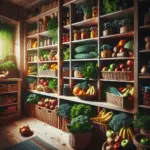Do succulents need drainage? The answer is a resounding yes! Succulents are unique plants that thrive in well-drained soil. Without proper drainage, your beloved succulents can suffer from root rot, which can be fatal. In this article, we’ll explore why drainage is vital for succulents, common mistakes to avoid, and how to provide the best environment for your plants. Read on to learn how to keep your succulents healthy and vibrant!
The Importance of Drainage for Succulents
Succulents thrive with proper drainage, as it is crucial for their health and growth. Without effective drainage, excess water can accumulate, leading to root rot and plant stress. Succulents have adapted to store water in their leaves, stems, and roots, making them susceptible to overwatering. Ensuring that water can flow freely away from the plant’s roots is essential to mimic their natural environment.
Why is Drainage Important for Succulents?
Succulents require a balance of moisture and airflow around their roots. A well-draining system allows water to be rapidly expelled while maintaining optimal moisture levels. This helps prevent root suffocation and fungal growth, which can be detrimental to the plant’s health. Furthermore, proper drainage ensures that nutrients from the soil remain available for absorption, supporting the succulent’s nutrient needs.
Optimal Drainage Solutions include using pots with adequate drainage holes, choosing the right soil mix, and understanding the signs of drainage issues. Materials like gravel or mesh at the bottom of pots can improve drainage efficiency, while specific soil compositions with sand or perlite increase drainage properties. Regularly monitor your succulents’ conditions to adjust watering and improve their drainage environment as needed.
How the Right Soil Affects Succulent Drainage
Choosing the right soil is crucial for ensuring that succulents have effective drainage. A common misconception is that any soil will do, but the truth is that succulents require a specific type of soil mix to thrive. Sandy, well-draining soil is ideal. It allows water to flow through quickly, preventing root rot caused by standing water. The best soil mixes for succulents often include ingredients like sand, perlite, or pumice.
These components help to create the porous environment succulents need, enabling the excess water to escape efficiently. Unlike traditional potting soil, which may retain too much moisture, a specially designed succulent mix encourages rapid drainage.
The right soil balance protects your succulents from overwatering, a common problem that can lead to plant diseases. Remember that each ingredient contributes uniquely: pumice provides structure, while perlite adds air pockets, which improves aeration for the roots.
Proper soil selection combined with suitable pot types can greatly enhance the draining capability, ensuring your succulents remain healthy and vibrant over time.
Types of Pots that Ensure Drainage for Succulents
Terracotta Pots
Terracotta pots are an excellent choice for succulents because they are porous and allow for easy evaporation of excess water. This natural material helps prevent waterlogged soil, providing superior drainage compared to non-porous options. The earthy aesthetic also complements the natural look of succulents, making them a popular choice among enthusiasts.
Ceramic Pots with Drainage Holes
Ceramic pots, when equipped with drainage holes, serve as another great option for succulent planting. The weight of ceramic can provide stability for larger plants, and the glaze can protect the soil from drying out too quickly while still allowing adequate drainage when paired with the right soil mix.
Plastic Pots
While plastic pots are less breathable than terracotta and ceramic, they can still work well if you ensure there’s a sufficient number of drainage holes. Plastic pots are lightweight and often come in a variety of styles, making them versatile for different home decors. However, it’s important to be extra cautious with watering as plastic can retain moisture longer than porous materials.
Metal Pots
Using metal pots can be an unconventional but stylish choice. Ensure they have good drainage holes to allow water to escape easily. Another tip is to line the pot with a breathable material to help regulate moisture and prevent overheating, which could lead to root rot in succulents.
Glass Containers
Glass containers are usually chosen for their aesthetic appeal. However, they often lack drainage holes, posing a challenge for succulent care. To mitigate this, you can place a layer of pebbles or gravel at the bottom of the container to enhance drainage and aeration, though this is not as effective as pots with built-in holes.
Choosing the right type of pot is crucial to providing adequate drainage for your succulents, as improper drainage can lead to serious health issues for these plants.
Signs of Overwatering in Succulents: What to Look For
Succulents are renowned for their ability to withstand dry conditions, but even these hardy plants can suffer from excess water. Recognizing signs of overwatering is crucial for maintaining their health. Pay attention to discoloration; leaves turning yellow, translucent, or soggy could indicate too much water. Notice if leaves are soft or mushy, as these are common symptoms of overwatering in succulents.
Another sign to monitor is the dropping of leaves, especially when new growth falls off easily. Overwatered succulents may also exhibit swollen leaves that appear overly full of water. Additionally, the presence of black or brown spots on leaves, known as edema, often results from excess moisture. Ensure your care routine includes a suitable watering schedule to prevent these issues.
Remember, understanding these signs helps to adjust your watering habits and ensure the effective drainage system you choose truly benefits your succulents’ health and growth. Monitoring your plants’ wellbeing enables you to take timely action against root rot and other water-related diseases.
Tips for Creating an Effective Drainage System
Ensure Proper Water Flow: To create an effective drainage system, make sure water can flow uninterrupted from the top to the bottom of the pot. Use pots with drainage holes and elevate them slightly to prevent water from pooling at the base.
Layering Material: Place a layer of rocks or pebbles at the bottom of your pot before adding soil. This helps facilitate drainage and prevents the roots from sitting in water.
Smart Soil Choices: Choose a well-draining succulent mix or create your own by combining potting soil, sand, and perlite. The soil should allow water to pass through quickly, preventing it from becoming waterlogged.
Regular Monitoring: Check for signs of water retention, such as soggy soil or yellowing leaves, and adjust your watering schedule accordingly. Ensure that no blockages occur in the drainage material.
Maintain Drainage Efficiency
: Regularly refresh the soil mix, especially if you notice compacting, which can hinder drainage efficiency. Pay attention to the climate and adjust your drainage approach in response to seasonal changes.
How to Avoid Root Rot in Succulents
Succulents require excellent drainage to prevent the dreaded root rot. Ensuring proper drainage is critical for their survival and thriving environment. Succulents are naturally adapted to arid conditions, meaning excessive moisture can be harmful.
To avoid root rot, choose pots with adequate drainage holes. These allow excess water to escape, preventing the soil from staying too wet. Using the right soil mix is also crucial. Opt for mixes specifically designed for succulents and cacti, as these often contain sand or perlite to enhance drainage.
Watering techniques play a significant role as well. It’s advisable to water deeply but infrequently. Allow the soil to completely dry out between waterings to mimic their natural environment. Using a pot with good drainage, along with well-draining soil, helps keep the roots dry, reducing the risk of rot.
Moreover, placing a succulent in an area with ample airflow encourages proper evaporation, further preventing root rot. Implement these strategies to enjoy healthy succulents, flourishing without the fear of root issues.
Soil Mixes: What to Include for Better Results
Creating the perfect soil mix is crucial for ensuring your succulents thrive. The right blend can significantly affect drainage, which is vital for these plants. A well-draining soil mix typically includes a combination of organic and inorganic materials. These materials serve different purposes; organic matter retains some moisture while providing nutrients, and inorganic substances help with drainage and aeration.
For your succulents, it is important to incorporate components like coarse sand, perlite, and pumice. These materials reduce compaction and enhance air circulation to the roots. Coarse sand improves drainage, preventing excess water from lingering in the soil. Perlite increases aeration while also lightening the overall soil mix, making it ideal for delicate root systems.
Organic Components
In addition to sand and perlite, a small amount of peat moss or coconut coir can be included to add some organic content. This helps in holding the necessary moisture without waterlogging. It’s crucial to maintain the right balance, as too much organic material can retain excessive water, leading to root rot.
It’s also advisable to include gravel or small stones at the bottom layer of your pot. This layer enhances drainage by allowing excess water to escape the root zone efficiently. Ensure the pot you use has drainage holes, facilitating this escape route.
By striking the right balance between these components, you create an environment where succulents can absorb the necessary moisture and nutrients without being overwhelmed by water. Such a soil mix not only fosters robust growth but also reduces the risk of diseases such as root rot.
Drainage and the Healthy Growth of Succulents
Understanding how drainage impacts succulent health is crucial for any plant enthusiast. When succulents are grown in containers that allow proper drainage, they thrive by avoiding excess water retention. Good drainage prevents overwatering, which is a common mistake leading to succulent death.
Choosing the right pot and soil type is essential for enabling this. Succulents prefer a well-draining soil mix, which often includes ingredients like sand, perlite, or small stones. These materials aid in fast water drainage, allowing the root system to remain healthy and rot-free.
Moreover, frequent signs of inadequate drainage include leaf drop and a mushy stem, indicating that the roots are struggling with too much moisture. By enhancing drainage, you promote the healthy growth of succulents, allowing them to absorb water efficiently without over-absorption.
Empowering your succulents with the right drainage will help them flourish and grow vibrantly. Whether they are houseplants or outdoor companions, ensuring proper drainage is key to their successful cultivation.
Terracotta Pots vs. Plastic Pots: Which is the Best Option?
When choosing between terracotta pots and plastic pots for your succulents, considering drainage is crucial. Terracotta pots are known for their porous material, allowing for air circulation and moisture evaporation. This feature can be particularly beneficial for succulents as it helps prevent overwatering, a common issue in succulent care. The clay material absorbs excess water, which can protect the roots from sitting in saturated soil.
In contrast, plastic pots are non-porous and retain moisture for a longer period. While they are lightweight and come in various styles, the lack of natural breathability requires more attention to watering schedules. They are better suited for environments where moisture retention is needed.
Both options can be effective if drainage holes are present, but the type of pot significantly impacts the plant’s water management. Using a well-draining soil mix and incorporating additional drainage solutions, such as adding pebbles or using mesh at the bottom of the pot, can support healthy succulent growth regardless of pot material.
Opt for terracotta if your succulents are outdoors in a humid climate or if you’re an overzealous waterer. Choose plastic pots if you’re in a dry area or prefer lightweight options that require less monitoring. Ultimately, the choice depends on your environment and care habits, but always focus on improving drainage to support thriving succulents.
Care for Drainage in Indoor Succulents
When caring for indoor succulents, ensuring proper drainage is crucial for their health and longevity. Without appropriate drainage, excess water can accumulate, leading to root rot and other problems. Begin by selecting a pot with adequate drainage holes; this allows excess moisture to escape, preventing waterlogging.
A well-draining soil mix is also essential. Consider a cactus or succulent soil mix, which is formulated specifically to retain the right amount of moisture while allowing excess water to pass through. Adding perlite or sand can further enhance the drainage capacity of your soil mixture.
Regular inspection of your succulents can help identify potential drainage issues. Look for signs such as yellowing leaves or mushy stems, which may indicate overwatering due to poor drainage. Adjusting your watering habits and ensuring that the pot and soil are suitable for sedentary water flow can significantly improve the health of your indoor succulents.
For those who prefer aesthetics, place your succulents in decorative pots without drainage, but keep them in a grow pot with holes inside. This way, you can have controlled watering in the grow pot and still maintain your preferred aesthetic looks.
Understanding these aspects of drainage can prevent common issues and promote robust growth, ensuring that your indoor succulents thrive with vibrant foliage and healthy roots.
The Importance of Drainage Holes in Succulent Pots
Succulents are well-known for their ability to store water in their leaves, enabling them to thrive in dry conditions. However, proper drainage is crucial for their survival, especially when planted in pots. Drainage holes offer a simple yet effective solution by allowing excess water to escape the soil, which helps prevent root rot—a common issue caused by overwatering.
Potting a succulent without drainage holes can lead to water accumulation at the bottom, suffocating the roots and hindering their access to oxygen. This situation encourages mold and bacterial growth, which could ultimately kill the plant. A pot with drainage holes promotes healthy growth by mimicking a succulent’s natural habitat, where water drains quickly through sand and gravel.
Why Choose Pots with Drainage Holes?
Regarding the health of your succulents, choosing the right pot can’t be overstated. Drainage holes allow for effective water flow, preventing overwatering and ensuring that your plant receives just the right amount of moisture. Each time you water your succulent, excess water moves through the soil and out of the drainage holes, preventing saturation and allowing the plant to dry out between watering sessions.
Not only do drainage holes help control the environment within the pot, but they also simplify the task of watering. They offer you the chance to water freely, knowing that any excess will be safely expelled from the pot, rather than collecting at the bottom.
Solutions for Drainage Problems in Succulents
Solutions for Drainage Problems in Succulents
When dealing with drainage issues in succulents, it’s crucial to address these problems promptly to prevent root rot and other adverse effects. Here are some effective solutions:
- Improve Soil Drainage: Use a well-draining soil mix specifically designed for succulents. Mix equal parts of potting soil, perlite, and coarse sand to enhance drainage and prevent water retention.
- Choose the Right Pot: Opt for pots with drainage holes. If your pot lacks these, consider drilling holes or double potting by placing a non-drainage pot inside another with holes.
- Layer with Gravel: Add a layer of gravel or small stones at the bottom of the pot. This will create space for water to settle and not touch the roots directly.
- Controlled Watering: Water succulents thoroughly but infrequently. Allow the soil to dry out completely between watering sessions.
- Elevate the Pot: Ensure that the bottom of the pot is elevated slightly to allow excess water to escape and air to circulate better, promoting faster drying.
By following these methods, you can enhance drainage for your succulents, ensuring they remain healthy and vibrant. Consistently monitor the moisture levels in the soil to forestall any potential drainage challenges.
To ensure the healthy growth of succulents, proper drainage is crucial. These plants are adapted to arid environments, where water quickly drains away, preventing root rot. Without adequate drainage, water can accumulate, leading to succulent diseases and even plant death.
A well-draining soil mix is essential, as it mimics their natural habitat. This kind of soil usually contains components like sand, perlite, or pumice, which help water to flow efficiently, keeping the roots dry.
Different types of pots play a significant role in maintaining optimal drainage.
Terracotta pots
are highly recommended because they are porous, allowing excess moisture to escape. On the other hand, plastic pots may retain more water, increasing the risk of overhydration.
It’s also important to watch for signs of overwatering, such as yellowing leaves or mushy stems. By observing these symptoms early, you can adjust your watering regimen accordingly.
Creating an effective drainage system often involves ensuring there are sufficient drainage holes in your pots. Additionally, raising pots slightly off the ground can improve air circulation and further aid in preventing water from lingering.
By choosing appropriate soil mixes and pots, and paying attention to the signs of drainage issues, you can support the thriving growth of your succulents.







